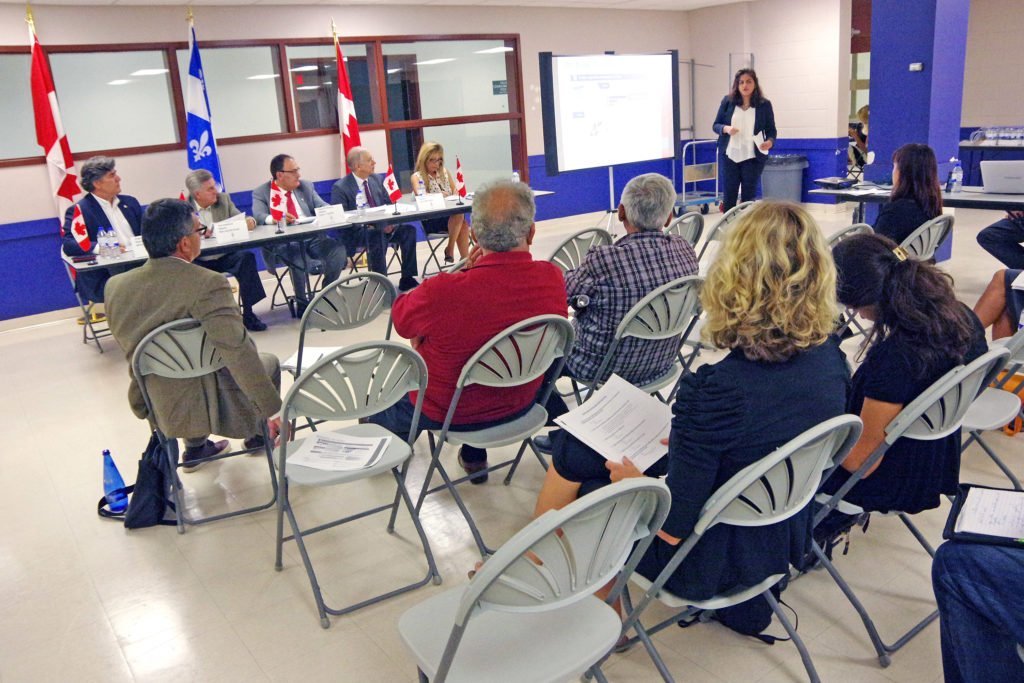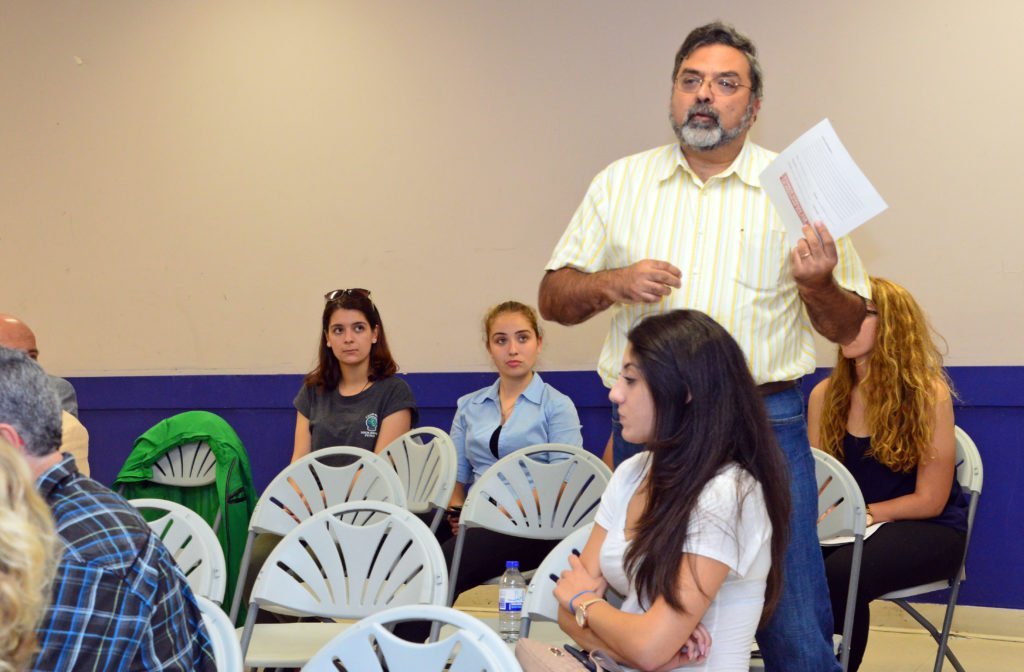Martin C. Barry
The Conservatives won the 2006 federal election with 40 per cent of the seats and 36 per cent of votes, followed by the 2008 election when they won 46 per cent of seats with 38 per cent of national support.
The Conservatives scored another win in 2011 when they finished with 54 per cent of the seats and 39.6 per cent popular support, while the Liberals won the 2015 election with 50 per cent of the seats but just 35.5 per cent of the national vote.
A flawed system?
These kinds of lob-sided election results – in which the seat count doesn’t jive with the popular result – are leading some observers to view Canada’s current electoral system as fundamentally flawed, according to Saint-Louis Liberal MP Francis Scarpaleggia, president of the Liberal government’s special electoral reform committee.
Scarpaleggia was at the Centre de Sablon in Chomedey on Sept. 13 to lead a public consultation meeting attended by 20 or so people, with three of Laval’s four MPs (Angelo Iacono [Alfred-Pellan], Yves Robillard [Marc-Aurèle-Fortin] and Fayçal El-Khoury [Laval-Les Îles]) also present.
Canada’s current electoral system, known as “first-past-the-post” or plurality voting, has voters indicating on the ballot the candidate of their choice, with the one receiving more votes than any other winning the election. The government’s actions date from a resolution passed at a Liberal Party of Canada convention in Montreal in 2014, a year before they formed the current government.

Some voting alternatives
Alternative types of voting system that were presented during the meeting included: Preferential or Ranked Voting, in which voters rank candidates in order of preference, with the winner requiring at least 50 per cent support; Proportional Representation, which increases the impact of the popular vote while weakening the link between voters and local representatives; Single Transferable Voting, in which electors vote for their most preferred candidate, and as the count proceeds and candidates are elected or eliminated, the vote is transferred to second-choice candidates; and Mixed Proportional Representation, which combines first-past-the-post and Proportional Representation. An added complication to some of these is that they involve electing more than one representative per riding.
While the NDP and the Green Party agree that Canada is overdue for an electoral reform and are participating fully, the official opposition Conservatives have been much less enthusiastic. The Conservatives have also been conducting an aggressive campaign on Twitter and other social media, demanding the Liberal government hold a referendum if any changes are made to the country’s electoral system.

Response by constituents
During a question and answer period following a PowerPoint presentation, several residents said what they thought of the proposed alternatives. Alain Ouimet of Alfred-Pellan said he tended to favour Mixed Proportional Representation, while adding, “I am mostly in favour of changing the actual model.”
One of the criticisms expressed during the meeting about Mixed Proportional Representation is that since it is a two-tier system, involving the election of representatives from local ridings as well political party representatives, the cost of sustaining such a system could easily be higher.
Viken Afarian of Laval-Les Îles said the present electoral system is “is one of the worst among the potential choices. I also am in favour of Proportional Representation, but at the same time as saying that we don’t have to increase the number of elected representatives because we could change the number of ridings to make sure that, I don’t know, say 75 per cent of representatives are elected by the ridings, 25 per cent nationally through party lists.
“For me this is not a worry but it’s not where I am going,” he added. “Preferential voting would be much better than what we have got. On the other hand, we will lose the vote expressed in first and second rounds by people who have become lost. We would be in the process of forcing the channelling of votes that perhaps the citizens don’t want.”
Against radical reform
George Guzmas, editor of the Laval News and a Laval-Les Îles resident, waded into the debate. He said that in Italy there have been 62 governments since World War II, largely because Italy has held elections with the Mixed Proportional Representation system. He also pointed out that in Greece, where a form of Proportional Representation is used, a neo-Nazi party gained the opportunity to run for the Greek parliament largely because of the nature of the electoral system.
“This is why I am against a radical reform of the electoral system,” he said, “because I think democracy in Canada and the electoral system are working very well. I know, too, that at the present time Italy is looking at the Canadian electoral system to change theirs.” Guzmas said he plans to present a written memorandum, including his opposition to a reform, to the electoral reform committee.
Mixed Proportional Representation
Michel Charuest of Alfred-Pellan suggested that Mixed Proportional Representation could help build bridges between political parties by encouraging them to work more closely, while reducing the tendency of parties to be partisan. He pointed to the example of Germany as a European country where Mixed Proportional Representation is used and the government is stable.
“That’s why I believe that Mixed Proportional Representation is one of the best systems,” said Charuest, while adding that Canada’s current electoral system favours regional parties, such as the Bloc Québécois, who have used it to their advantage.
The Liberal government’s attempt at electoral reform comes two years after the former Conservative government passed the Fair Elections Act, which was attacked by opponents (including the Liberals) as an attempt by the Conservatives to change the country’s electoral system to the Conservatives’ advantage. Iacono and El-Khoury maintained adamantly that there is nothing partisan in the Liberals’ current efforts.
‘Not partisan,’ say Liberals
“Absolutely not,” said El-Khoury. “All the decisions will be based on facts, on evidence, on research, on consultation. You know, for this particular reform our minister is travelling and we are doing consultation from coast to coast to coast. We are collecting data, evidence and we will provide our report to the Chamber, but all the citizens of Canada are being consulted.”
Iacono noted that the Liberals “invited all the other parties to be part of this process, so we’re not really doing it on our own. We’re inviting everybody to be part of it.” As for the indifferent response from some opposition MPs, he acknowledged, “They are not much collaborating, but we have continuously invited them to be part of this change to help us to come up with something that will represent all Canadians.”
Scarpalegggia, for his part, pointed out that the Liberal government’s good intentions should be evident given the fact they agreed to put together the electoral reform committee with a minority of Liberals as members. “The rules of the House of Commons make it such that committees reflect the distribution of seats in the House, but this is an exception,” he said, adding “I think this is a gesture of good faith.”














